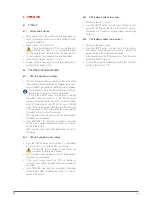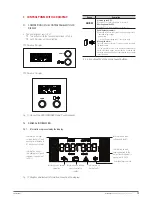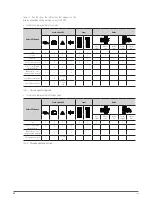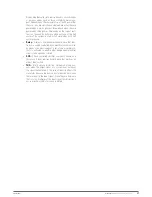
26
SALICRU
Models.
ADVANCE T
Available power ratings (VA / W).
850VA / 595W
1000VA / 700W
1500VA / 1050W
2000VA / 1400W
3000VA / 2100W
Relative humidity.
0..90 % non-condensing.
Protection rating.
IP20
dimensions (mm)
depth × width × height.
UPS modules.
327 x 140 x 191
416 x 196 x 342
optional battery module.
-
327 x 140 x 191
416 x 196 x 342
weight (kg).
UPS modules.
11.8
13.5
14.4
14.4
27.6
UPS modules (b1).
-
8.3
10.2
12.5
22.1
optional battery module.
-
10.2
10.2
10.2
31.5
Safety.
en IeC 60950-1
en IeC 60240-1
electromagnetic compatibility (emC).
en IeC 60240-2
operation.
en-IeC 62040-3
marking.
Ce
Quality system.
ISo 9001 and ISo 140001 (certified by SgS)
Tab. 15.
ADVANCE T general technical specifications.
9.2. glossary.
•
AC.-
Alternating current is electric current in which the
magnitude and direction vary cyclically. The waveform of
the most commonly used alternating current is that of a
sine wave, since this achieves a more efficient transmis-
sion of energy. In certain applications, however, other peri-
odic waveforms are used, such as triangular or square.
•
Bypass.-
manual or automatic, this is the physical con-
nection between the input of an electrical device and its
output.
•
DC.-
direct current is the continuous flow of electrons
through a conductor between two points with different po-
tential. Unlike AC, in dC, electrical loads always circulate
in the same direction from the point of greatest potential to
the lowest. Although dC is commonly identified as a con-
tinuous current (for example, that supplied by a battery),
any current that always maintains the same polarity is con-
tinuous.
•
DSP.-
digital signal processor. A dSP is a processor or
microprocessor-based system that has a set of instructions,
hardware and optimised software for applications that re-
quire numerical operations at very high speed. because of
this, it is especially useful for the processing and represen-
tation of analogue signals in real time: in a system that
works in this way (real time) samples are usually received
from an analogue/digital converter (AdC).
•
Power factor.-
The power factor, Pf, of an AC circuit is de-
fined as the ratio between active power, P, and apparent
power, S, or as the cosine of the angle formed by the cur-
rent and voltage factors, designated in this case as cos
f
,
where
f
is the value of the angle.
•
GND.-
This stands for gRoUnd or eARTh and, as the name
indicates, refers to the potential of the surface of the earth.
•
EMI filter.-
filter capable of significantly reducing electro-
magnetic interference (emI), which is the disturbance that
occurs in a radio receiver or in any other electrical circuit
caused by electromagnetic radiation coming from an ex-
ternal source. electromagnetic interference is also known
as radio frequency interference (RfI). This disturbance can
interrupt, degrade or limit the performance of the circuit
•
IGBT.-
An insulated gate bipolar transistor is a semicon-
ductor device that is generally used as a controlled switch
in power electronics circuits. This device possesses the
characteristics of the gate signals of field effect transis-
tors with the capacity for high current and low saturation
voltage of the bipolar transistor, combining an isolated
feT gate for input and control and a bipolar transistor as a
single switch in a single device. The IgbT’s excitation cir-
cuit is similar to that of the moSfeT, while the conducting
characteristics are similar to those of the bJT.
•
Interface.-
In electronics, telecommunications and hard-
ware, an interface (electronics) is the port (physical circuit)
through which signals are sent or received from one system
or subsystem to another
•
kVA.-
A volt-ampere is the unit used for apparent power in
electrical current. In dC, it is practically equal to real power
but, in AC, it can differ from this depending on the power
factor.
•
LCD.-
Liquid crystal display, a device invented by Jack
Janning, who was an employee of nCR. It is an electrical
system for data presentation formed by 2 transparent
conductive layers and a special crystalline material in the
middle (liquid crystal) which have the ability to orientate
light as it passes through.
•
LED.-
Light-emitting diode, a semiconductor device (diode)
that emits light that is almost monochromatic, that is to say,
it has a very narrow spectrum when it is polarised directly
and is penetrated by an electric current. The colour (wave-
length) depends on the semiconductor material used in the
construction of the diode, and can vary from ultraviolet,
passing through the visible light spectrum, to infrared, the
latter called IRed (infra-red emitting diode).
•
Circuit breaker.-
A circuit breaker is a device capable of
interrupting the electrical current of a circuit when it ex-
ceeds certain maximum values.
•
On-line mode.-
A device is said to be on-line when it is
connected to a system, is operative, and normally has its
power supply connected.
•
Inverter.-
An inverter is a circuit used to convert dC into
AC. The function of an inverter is to change a dC input
voltage to a symmetrical AC output voltage, with the mag-
nitude and frequency desired by the user or designer.
•
Rectifier.-
In electronics, a rectifier is the element or cir-
cuit that converts AC into dC. This is done by using rectifier



































